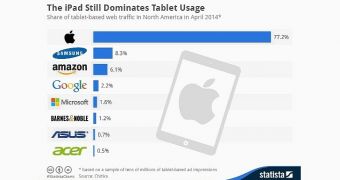Microsoft is investing a fortune to make its tablet efforts a bit more successful, but when it comes to actual figures, Redmond is still trailing behind its key competitors.
It's no secret that ever since it introduced the first Surface RT in October 2012, Microsoft continued the push in the tablet industry not only with several new models, but also with updated firmware that would enhance usability and provide some new features that aren't yet available on other devices.
A new chart published today by Statista and showing tablet-based web traffic in North America in April 2014, Microsoft is only the fifth company in the rankings, well behind the industry leader Apple.
Figures provided by Chitika for April 2014 based on tablet impressions in its ad network show that Apple is leading the pack with a share of 77.2 percent, followed by Samsung and its Android tablets with 8.3 percent.
Surprisingly, Amazon is third with 6.1 percent, while Google comes next with 2.2 percent. Microsoft is only fifth with 1.6 percent, followed by Barnes and Noble with 1.2 percent, ASUS with 0.7 percent, and Acer with 0.5 percent.
But although it's doing so poorly as compared to Apple, Microsoft is apparently inspiring the Cupertino-based company when it comes to the improvements it has to make to its tablets.
Word is that Apple is currently working to implement a “real” multi-tasking feature in iOS 8 that would allow iPads to run two applications side by side, in a similar way with the Surface. Microsoft's Surface, which runs either Windows RT or Windows 8.1, depending on the model you choose, featured such multi-tasking options from the very beginning, allowing users to run two or more apps side by side.
At the same time, Microsoft continues investments in its Surface lineup and recently unveiled the new Surface Pro 3, an upgraded model that comes with new hardware and runs the full version of Windows 8.1.
The Surface Pro 3 features a 12-inch screen and comes with three CPU options, including Intel Core i3, i5, and i7. There are two RAM choices, 4 GB and 8 GB, and several storage versions that go all the way up to 512 GB.
The biggest problem with the Surface Pro 3 is the price, as the top-of-the-range model, which comes with an i7 chip, 8 GB of RAM, and 512 GB of storage space, costs no less than $2,000 (€1,500), which is clearly a major setback for end users who'd like to buy such a device.

 14 DAY TRIAL //
14 DAY TRIAL //